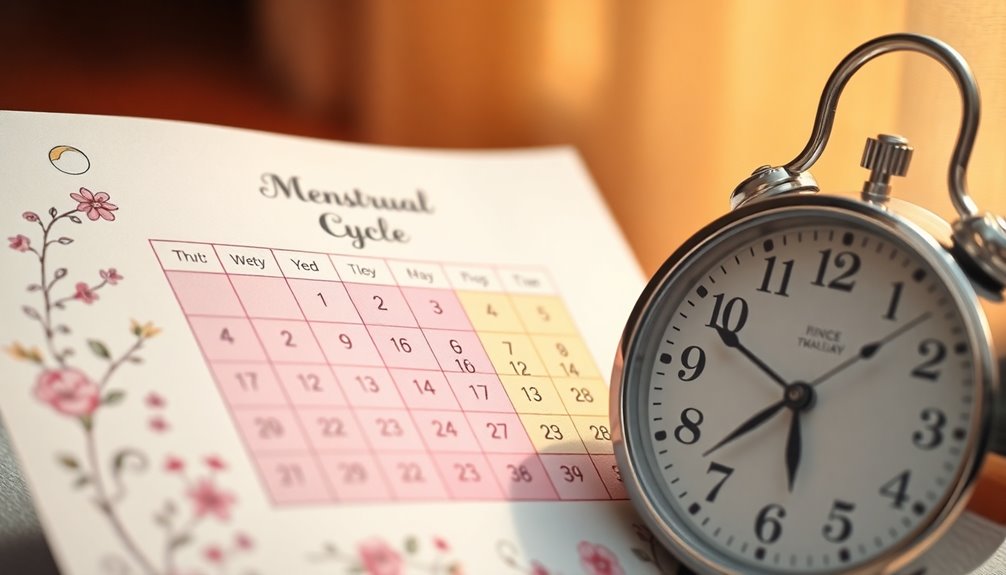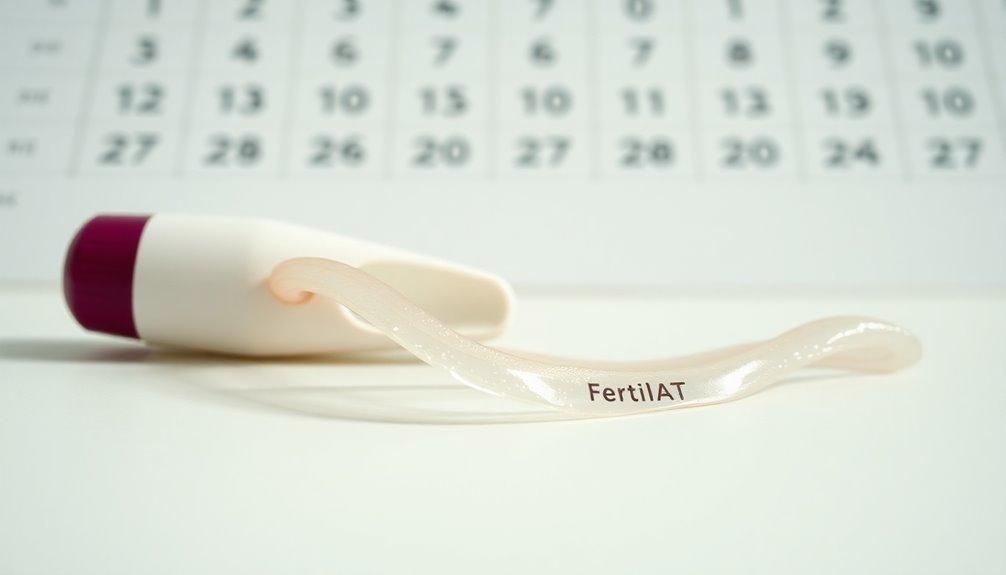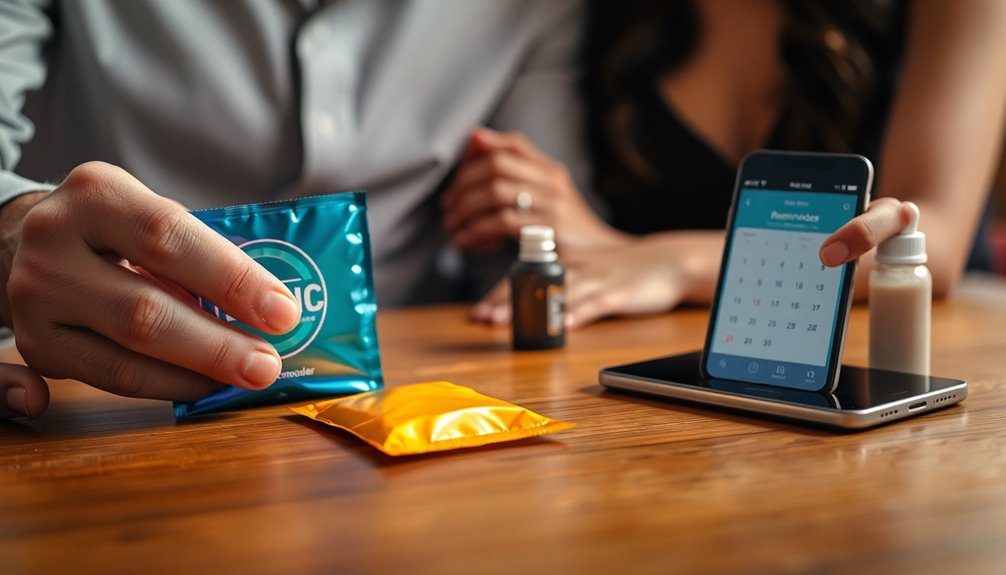To avoid pregnancy, you should understand your menstrual cycle and track your fertile window. The most fertile days are about five days before ovulation and the day of ovulation itself, typically 10-16 days after your last period. During this time, unprotected sex greatly increases the risk of conception. You can enhance your awareness using methods like monitoring basal body temperature or observing changes in cervical mucus. Combining natural family planning with reliable birth control can further prevent pregnancy. Knowing these details can help you make informed decisions, leading to more effective pregnancy prevention strategies ahead.
Key Takeaways
- Avoid unprotected sex during the fertile window, which is the five days leading up to ovulation and the day of ovulation itself.
- Track your menstrual cycle accurately to identify ovulation, which typically occurs 10-16 days before your next period.
- Use methods like basal body temperature and cervical mucus observation to predict ovulation and avoid high-risk days.
- Consider combining natural family planning with reliable birth control methods for enhanced pregnancy prevention.
- Be aware that sperm can survive in the female reproductive tract for 2-5 days, allowing for potential conception even with pre-ovulation intercourse.
Understanding the Menstrual Cycle

To understand the best time to have sex and avoid pregnancy, it's essential to grasp the menstrual cycle. The average cycle lasts about 28 days, with ovulation occurring 10-16 days before your next period.
Your fertile days span from five days before ovulation to the day itself, making this the highest risk period for conception. Keep in mind that sperm can live 2-5 days in the female reproductive tract, so unprotected sex just before ovulation can lead to pregnancy.
To effectively avoid pregnancy, track your menstrual cycle using the calendar method, along with observing basal body temperature and cervical mucus changes.
Having sex during menstruation might seem safer, but cycle length variability can still pose risks.
Identifying the Fertile Window

Identifying your fertile window is essential for avoiding pregnancy, especially if you want to time intercourse carefully.
The fertile window typically spans five days before ovulation and the day of ovulation, making this the highest risk period for conception. Ovulation usually occurs about 12 to 16 days before your next menstrual period, so tracking your menstrual cycle helps you pinpoint these fertile days.
Remember, sperm can survive in your reproductive tract for 2-5 days, so unprotected sex during this time greatly increases the chance of pregnancy.
Pay attention to changes in cervical mucus, which often becomes clear and stretchy as ovulation approaches, further aiding in identifying your fertile window effectively.
Timing and Pregnancy Risks

Understanding the timing of your menstrual cycle is essential in managing pregnancy risks. The days right before ovulation, typically 10-16 days after your last period, are your most fertile.
Engaging in unprotected sex during this window, especially the 5 days leading up to ovulation and the day of ovulation, greatly increases your chances of pregnancy. Remember, sperm can survive in your reproductive tract for 2-5 days, meaning intercourse just before ovulation can still lead to conception.
If you're using natural family planning, be aware that up to 24% of users may face unplanned pregnancies without strict adherence.
To effectively prevent unintended pregnancies, consider combining natural family planning with reliable birth control methods during your fertile days.
Birth Control Effectiveness

When it comes to preventing pregnancy, understanding the effectiveness of different birth control methods is essential.
Hormonal options like pills and patches can be highly effective if you stick to the schedule, while non-hormonal choices like IUDs and condoms offer reliable protection as well.
Knowing how each method works can help you make informed decisions about your sexual health.
Hormonal Methods Overview
Hormonal birth control methods offer one of the most effective ways to prevent pregnancy, boasting over 99% efficacy when used correctly and consistently.
These contraceptives, including pills, patches, and injections, primarily work by preventing ovulation, thickening cervical mucus to block sperm, and thinning the uterine lining to prevent implantation.
Pills need to be taken daily at the same time, while patches are applied weekly and injections are given every three months.
For long-term protection, the hormonal IUD can last between 3 to 7 years.
It's essential to consult your healthcare provider to discuss your individual health needs and determine the most suitable hormonal birth control method for you, ensuring you maximize your effectiveness in preventing pregnancy.
Non-Hormonal Options Explained
Non-hormonal birth control options provide effective alternatives for those seeking to prevent pregnancy without altering hormonal levels.
Barrier methods like condoms and diaphragms are about 82% effective with typical use, while the copper IUD boasts over 99% effectiveness for up to 10 years.
If you're interested in fertility awareness methods, tracking your menstrual cycle and ovulation can yield up to 99% effectiveness with perfect use, though it averages around 76-88% in real life.
Spermicides, which can be used alone or alongside barriers, are about 72% effective.
Natural Family Planning Methods

Natural Family Planning (NFP) methods offer a reliable way to track your fertility and avoid pregnancy without the use of artificial contraception. By understanding your menstrual cycle, you can predict ovulation and identify fertile days, typically five days before ovulation.
The Standard Days Method uses CycleBeads to mark these fertile days, making it effective for women with 26-32 day cycles.
The Basal Body Temperature method involves daily temperature monitoring, noting a rise after ovulation. Meanwhile, the Cervical Mucus method observes changes in mucus consistency, indicating fertility.
For enhanced effectiveness, you can combine these methods, such as in the Symptothermal Method.
Just remember, strict adherence is essential, as failure rates can be as high as 24 out of 100 women in typical use.
Importance of Tracking Ovulation
Tracking your ovulation is essential for understanding your fertile window, which can help you avoid unintended pregnancies.
By monitoring your menstrual cycle, you can pinpoint when ovulation is likely to occur, usually 10-16 days before your period.
Recognizing signs of ovulation, like changes in cervical mucus, makes it easier to time sexual activity effectively.
Understanding Fertile Window
Understanding your fertile window is vital if you want to avoid pregnancy effectively. This fertile window typically spans five days before ovulation and the day of ovulation, when your chances of conception are highest.
Ovulation usually occurs 10-16 days before your next menstrual period, making it essential to track ovulation accurately. You can do this by monitoring your basal body temperature and observing changes in your cervical mucus, alongside calendar calculations based on your menstrual cycle.
Remember, sperm can survive in your reproductive tract for 2-5 days, meaning intercourse just before ovulation can lead to unintended pregnancies.
Tracking Menstrual Cycle
Knowing when you're most fertile can greatly enhance your efforts to avoid pregnancy.
Tracking your menstrual cycle helps you identify ovulation, which typically occurs 10-16 days before your next period. The fertile window, the five days leading up to ovulation and the day itself, carries the highest risk for unprotected sex.
To effectively manage this, consider these methods:
- Calendar Method: Record cycle lengths to predict ovulation accurately.
- Basal Body Temperature: Monitor your temperature daily to detect ovulation shifts.
- Cervical Mucus Observation: Track changes in mucus to identify fertile days.
Using Basal Body Temperature

Using basal body temperature (BBT) effectively can help you avoid pregnancy by pinpointing your fertile days.
To track your basal temperature, measure it daily at the same time each morning before getting out of bed, and record it accurately. After ovulation, your temperature usually rises by 0.2°C (0.4°F), marking the end of your fertile window.
To reduce the chance of conception, avoid intercourse during the five days leading up to ovulation and the day of ovulation itself. For better accuracy, consider combining BBT tracking with other methods.
Keep in mind that factors like illness or stress can affect your readings, so consistent monitoring over several cycles is essential for identifying your non-fertile days clearly.
Examining Cervical Mucus

As you track your menstrual cycle, examining cervical mucus can reveal essential information about your fertility. This natural substance changes throughout the month, particularly around ovulation.
Here's what to look for:
- Fertile Days: Just before and during ovulation, cervical mucus becomes clear, slippery, and stretchy, signaling peak fertility.
- Non-Fertile Days: After ovulation, it thickens and turns cloudy or sticky, indicating lower chances for conception.
- Daily Tracking: Evaluating the texture, amount, and stretchiness of your cervical mucus daily helps you identify your fertile and non-fertile days.
Consulting Healthcare Providers

Consulting healthcare providers is essential if you want personalized advice on effective birth control methods that suit your health and lifestyle.
These professionals can guide you on the timing of sexual activity in relation to your menstrual cycle, helping maximize effectiveness in avoiding pregnancy.
Regular check-ups allow you to monitor and adjust your contraceptive methods based on any changes in your health or lifestyle.
Additionally, healthcare providers offer valuable education on fertility awareness methods, teaching you how to accurately track ovulation and identify your fertile days.
Engaging in open discussions about family planning empowers you to make informed decisions regarding your reproductive health, ensuring that you choose the best path for your needs.
Common Misconceptions About Fertility

You might think that having sex during your period guarantees you won't get pregnant, but that's a common misconception.
Sperm can stick around for days, and if you ovulate soon after, you could still conceive.
Let's clear up these myths about fertility and the timing of ovulation to help you make informed choices.
Fertility During Menstruation
Many people assume that having sex during menstruation is a foolproof way to avoid pregnancy, but this belief can lead to unexpected consequences.
Here are three key misconceptions about fertility during this time:
- Sperm Longevity: Sperm can survive in the female reproductive tract for 2-5 days, meaning ovulation can still lead to pregnancy if it occurs shortly after your period.
- Fertile Window Overlap: If you have a shorter menstrual cycle, your fertile window might overlap with the end of menstruation.
- Unprotected Intercourse Risks: Even though the probability of pregnancy is lowest right before menstruation, unprotected intercourse can still result in conception, especially with inconsistent cycle lengths.
Additionally, understanding your menstrual cycle is essential for effective contraception and preventing unintended pregnancy.
Sperm Longevity Misunderstandings
While some believe that sperm can't lead to pregnancy during menstruation, this misconception can be risky. Sperm can survive in your reproductive tract for 2 to 5 days, meaning unprotected sex a few days before ovulation can definitely result in pregnancy.
Many think that having sex during your period is safe, but sperm can remain viable and potentially fertilize an egg if ovulation occurs shortly after menstruation ends. Additionally, shorter menstrual cycles increase the chances of ovulation happening soon after your period, raising the risk of unintended pregnancy.
Recognizing the timing of ovulation in relation to sperm longevity is essential for effective control methods if you're looking to avoid pregnancy. Always stay informed about your fertility and menstrual cycles.
Ovulation Timing Myths
Understanding ovulation timing is essential for effective pregnancy prevention, yet several myths can cloud this knowledge. Here are some misconceptions to be aware of:
- Ovulation doesn't always happen mid-cycle: It typically occurs 10-16 days before your next period, so precise timing is important.
- Menstruation isn't always safe: Sperm can survive 2-5 days in your body, meaning conceiving is possible if ovulation occurs soon after your period ends.
- Fertile window is broader than you think: It includes the five days leading up to ovulation and the day itself, so tracking multiple days is critical.
Using fertility awareness-based methods alongside the calendar rhythm method can help prevent pregnancy, even if you have irregular menstrual cycles.
Frequently Asked Questions
When Is the Best Time to Have Sex and Not Get Pregnant?
When you're planning to have sex, consider your menstrual cycle.
You'll want to track your ovulation, which usually happens around day 14 of a typical 28-day cycle. Engaging in sex during the luteal phase, from ovulation until your next period starts, is generally safer for avoiding pregnancy.
If your cycles are irregular, use multiple methods like tracking basal body temperature and observing changes in cervical mucus to enhance your accuracy.
When Is the Least Likely Time to Get Pregnant?
Imagine you're counting down the days on your calendar, feeling a mix of excitement and uncertainty.
The least likely time to get pregnant is right before your period, in those final days when ovulation has already passed. You're safe during the week after menstruation too, as ovulation usually occurs 10-16 days before your next cycle.
Just keep in mind that shorter cycles may shift things, so stay aware of your body's rhythm.
How Many Days Before or After a Period Is Safe for Sex?
When considering how many days before or after your period are safe for sex, it's crucial to track your cycle.
Generally, the days immediately after your period are less fertile, but if your cycle is shorter, ovulation can happen soon after.
Aim to avoid unprotected sex during the five days leading up to ovulation.
In Which Week of Pregnancy Sex Is Not Allowed?
In your pregnancy, it's essential to be aware of when sexual activity mightn't be advisable.
Generally, sex is considered safe during the first and second trimesters unless your healthcare provider suggests otherwise due to complications.
In the third trimester, especially if you experience signs of preterm labor or other issues, you may need to avoid sex.
Always consult your healthcare provider for personalized guidance and to guarantee the safety of you and your baby.
Conclusion
In traversing the complexities of your menstrual cycle, understanding when to avoid pregnancy can seem intimidating. While the fertile window presents a heightened risk, your body also offers signals that can guide you. Balancing natural methods and reliable birth control can empower you to take control of your reproductive health. Remember, though, that even the best-laid plans can falter, so consulting a healthcare provider is key to ensuring your choices align with your goals for family planning.










